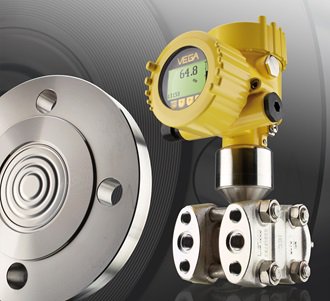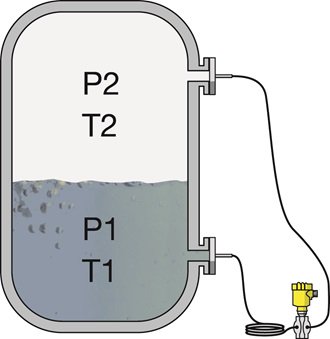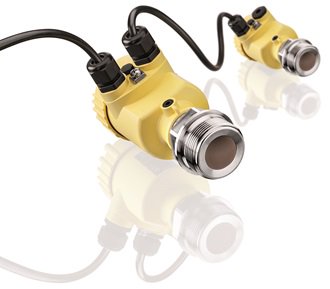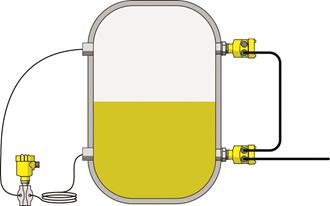Level Measurement 101: Understanding Differential Pressure
Using two pressure measurement values and a little math, differential pressure can calculate level, flow, interface, and even density. Process engineers know and trust differential pressure because it’s a tried and true method for controlling industrial processes. Its versatility and variety of outputs only make it that much more valuable across industries.
This paper will focus solely on how differential pressure is used to calculate a liquid level measurement in pressurized tanks. Advantages, limitations, and common industrial applications for differential pressure will be discussed.
How differential pressure works
The traditional differential pressure measurement consists of a dual sided diaphragm that senses pressure from the bottom of the vessel on one side and from the top of the vessel on the other. These opposing pressure measurements push on opposite sides of the dual sided diaphragm, and the resultant measurement is the pressure difference between the two, or differential pressure. Traditional differential pressure covers a wide application spectrum with the ability to detect differential pressures of only a few millibars.
The connections to the vessel are traditionally made in two different ways – impulse lines or capillary lines. Impulse lines are hard lines that allow the fluid or gas in the process to directly contact the diaphragm in the measurement device, and the lines become a part of the process. Capillary lines separate the sensor from the process by using a flange with a metal diaphragm mounted to the vessel. Connected to these external diaphragms are flexible, armor coated lines filled with oil. The remote seals remove the pressure transmitter from potentially damaging process parameters such as high temperatures or caustic materials.
Both arrangements are measuring pressure. The pressure measurement at the bottom of the tank or vessel is measuring the overall pressure created by the fluid and the vapor space above it, while the pressure measurement at the top is only accounting for that head or static pressure. This arrangement allows the static pressure to be “removed” from the overall measurement, leaving the pressure generated by the fluid and allowing us to infer level.
Common applications for differential pressure
Differential pressure is used to measure level of liquids and liquefied gases in pressurized tanks. Pressurized tanks are used for a number of reasons like providing a constant output, eliminating foam, providing a barrier for caustic materials, and liquefying gas for easier storage. In all of these scenarios, a differential pressure transmitter is only going to measure the difference between the static pressure and the overall pressure. It takes a little math to calculate the product level.
The standard hydrostatic pressure formula consists of three variables: pressure, density, and height. The sensor measures pressure, density is input as a constant by the customer, and the height is the product level. For this formula to work, density is key and must remain fairly constant. With a known density and pressure value, the pressure sensor’s electronics can accurately and reliably calculate liquid level from the differential pressure.Limitations of differential pressure
Differential pressure is a proven level measurement method, but it does have its drawbacks. For starters, installation requires stopping the process and draining the vessel where the measurement is made. This can be a costly or time-consuming process, especially if there are multiple vessels requiring this type of measurement. Additionally, the impulse lines and capillary lines used in differential pressure measurements are susceptible to outside influences. If these lines are in high traffic areas, they’re at risk of being crushed, and if outside of a climate controlled area, lines can heat up or chill, causing a change in material density and a level measurement error. Fortunately, there is a workaround for these common issues.
Electronic Differential Pressure
A desire to do things better and more efficiently has led to the creation of electronic differential pressure, using an innovative combination of software and hardware. This system uses two individual pressure sensors mounted directly to the vessel or tank, connected by a small electrical cable. This setup forgoes the traditional dual sided transducer and the need for impulse or capillary lines, making installation and maintenance easier.
Electronic differential pressure eliminates the need for impulse lines or capillary lines, which removes any susceptibility to outside influences causing a measurement error. It also opens up the possibilities to better diaphragm options like ceramic, which is abrasion resistant and better-suited to withstand harsh environments. Avoiding impulse or capillary lines and using a measurement cell ten times harder than stainless steel can prolong accurate level measurements with minimal to no maintenance.
Two separate pressure sensors working in tandem also allows for new ways of doing things, including density compensated level. This particular output uses two pressure measurements to constantly calculate density, then use the latest density to calculate continuous level. Density compensated level is ideal for measuring liquid level when the fluid properties are constantly changing in a process.
Electronic differential pressure doesn’t eliminate the need or usefulness of traditional differential pressure. It only expands upon the value differential pressure measurements can provide. Each method has its benefits and drawbacks, and users must decide what measurement they’re trying to better understand within their process.Conclusion
Differential pressure has been around a long time, and it’s a versatile technology that uses a single measurement to provide a variety of outputs, including level. This is why it has always been a reliable method for level measurement in pressurized tanks. Accuracy and consistency have only been improved upon with better sensors and electronics like VEGA’s VEGADIF 85. The measurement’s versatility is only matched by the sensor, which has customizable options, including multiple housing positions, allowing this sensor to go where previous differential pressure sensors couldn’t fit. Additionally, electronic differential doing all of this and more, opening up even more measurement options to processors. All of this proves differential pressure will continue to prove itself useful now and for much longer into the future.
Export this article
Download as PDFShare this article
Comments ({{comments.length}})
{{getCommentAuthor(comment, "Anonymous")}} {{comment.timestamp | date : "dd.MM.yyyy HH:mm" }}
{{comment.comment}}





